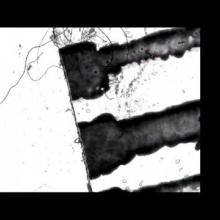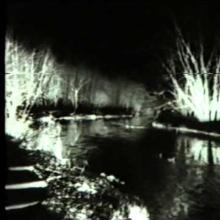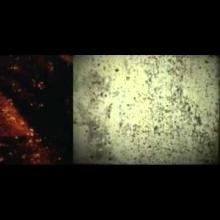A two-hour film consisting of heavily edited frame by frame collage/montage/hand painted/ripped/cut/etched found footage culled from numerous sources, including a 1970's public speaking instructional film, 'Themes From The Odyssey', 8mm stag films, 'Self Protection For Women', a biography of Vincent Van Gogh, ethnographic documentaries, science films, home movies, 'The Frog Prince', a film about underwater sound, and many other assorted educational films.
Through the use of juxtaposition of images (which may by nature become narrative and/or symbolic), rapid movement of form and texture, and repetition of motifs, an intricate visual structure is created which allows the viewers to experience and create their own unique readings. The film is silent, which allows one to follow the rhythm of the edits and movements of form and color within the frame without audio distraction against the complex visual structure.
Thus assembled, Regarding Penelope's Wake weaves between the multiple layers of experimental narratives and themes, structural abstractions and patterns of cut celluloid, intertwining rhythms of form, texture and light, visual metaphors, and the interactions between the elements. Form becomes amorphous as time is spun within the individual viewer's attentions.
Work on Regarding Penelope's Wake began December of 2000 and completed March of 2002. The digital transfer was completed by mid summer. This is my first finished work. While attending The School of the Art Institute Of Chicago I worked on a five hour film consisting of super 8 and 16mm found footage collage work similar in style to Penelope's. Except for fragmentary screenings at SAIC, this film has not been shown. I plan on restoring and completing this earlier project as soon as my current film is finished, hopefully by spring 2003. In one sense, Regarding Penelope's Wake was an act of return and a reconnecting to my past and to my original goals of being a filmmaker and artist, interests which I had slowly abandoned for several years.
I work on film in a rather unconventional way. I take sections of film off the reels and view them directly into the light. I edit with a guillotine tape splicer and scotch tape (much to the horror of the the technicians at the processing labs). I then use a manual Moviescope viewer to look at the edits. I work amid literal piles of unwound film. The film is often cut and spliced every couple of frames. 8mm and other 16mm frames are overlayed throughout. Strands of multiple frames are taped together and frames are cut out and inset into larger frames. Because of the physical thickness of the finished film and the irregularity of the sprocket holes due to the heavy editing and to the shrinkage of old film stocks, the film cannot run through a projector or a printer. It will run through a rank transfer machine - that's why the screening copy of my film is on mini dv. The transfer is taken directly from the original work. Aside from the lack of projector flicker, the colors and sharpness of image are happily an excellent quality duplication/translation/variation of the original film object, as are the DVDr and VHS works copied from that. In many ways I view my work as moving painting, visual music, and story telling through philosophical musings and experiments. I prefer not to speak much about the meanings of my film; I'd much rather let the viewers draw their own conclusions. - Michele Smith
Watch more films by Michele Smith in her Youtube channel.



Add new comment